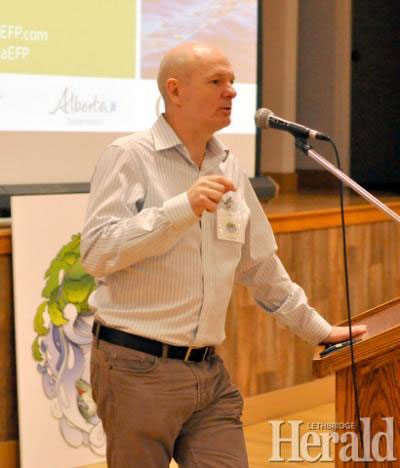
The demand for sustainable sourcing is growing in the agriculture industry, and environmental farm plans are a way producers can get out in front of them, says an EFP director.
Paul Watson was a speaker at the recent Oldman Watershed Council “Holding the Reins” landowner summit, where he told those in attendance about an increasing demand in food markets from sellers and consumers for documentation regarding their ethical farming practices and the role EFPs can play.
“We’re trying to make (the EFP) responsive to industry, and make it the environmental backbone of sustainable sourcing programs, so that if you have a farm plan, you’re covered in the environment,” he said.
Watson said the demand for sustainable sourcing and the demand for proof of that sustainability doesn’t mean practices need to be changed, or new techniques need to be adopted. Instead, the process will simply require more documentation as they are being done.
He also noted there is little interest in what is happening at the individual farm level. Rather, large companies and their customers are more interested in what is happening in the region, the industry and in Canadian agriculture as a whole.
“What changes are being made that make Canadian Agriculture better?” he asked.
In each of these areas of public concern, there are a number of considerations to be aware of: social criteria, including human rights; worker conditions; social protection; employment relations and human development; ethics criteria, including no forced or child labour; prevention of corruption; and compliance with legislation; management criteria, including economic viability; sustainable management and supply chain responsibilities; and environmental criteria, including soil conservation, agrochemical use, nutrient management, biodiversity enhancement and protection, waste and water.
“They help farmers and producers change their operation in a way that helps the land, helps profitability on their farm, and they also incorporate a form of transparency so when someone is an EFP farmer, the consumer knows the food coming from that place is properly raised,” said Cody Spencer, OWC Watershed Legacy Program Manager.
“There is a lot of big corporations that are now looking for this and only deal with farmers and ranchers that have the EFP.”
Watson said there is an opportunity for producers to get out in front of the movement before it is demanded throughout the entire industry, and that, by and large, the areas of concern involve strategies and practices most Canadian producers already use.
“This is broadly based among lots of the food giants,” he said. “They are all saying they would like proof for their clients that the practices that are being used in the industry as a whole are sustainable. By and large, in Canadian agriculture, we do a really good job.”
Watson said the biggest concern for many producers is how much additional work will need to be done for these plans. He said efforts are being made to ensure the process is not overly cumbersome.
“We’d like to get the EFP down to where you maybe spend a couple hours on it once every five years,” he said.
J.W. Schnarr
LETHBRIDGE HERALD
[email protected]
Follow @JWSchnarrHerald on Twitter
 Initiative
Initiative